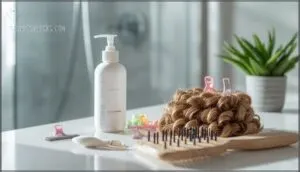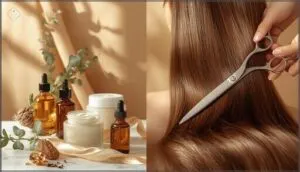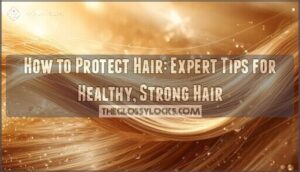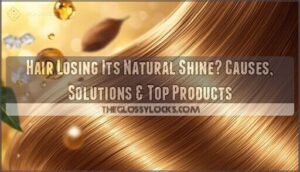This site is supported by our readers. We may earn a commission, at no cost to you, if you purchase through links.
 Your hair follicles don’t follow a calendar—they follow a cycle. While you’re focused on length, about 9-15% of your scalp hairs are quietly resting in a dormant phase, preparing to shed and make room for new growth.
Your hair follicles don’t follow a calendar—they follow a cycle. While you’re focused on length, about 9-15% of your scalp hairs are quietly resting in a dormant phase, preparing to shed and make room for new growth.
This natural rhythm explains why consistent hair growth and maintenance requires more than wishful thinking or expensive products. Your follicle shape, genetic blueprint, and even your stress levels influence whether your strands reach their full potential or break midway through their journey.
The difference between hair that grows strong and hair that stalls often comes down to understanding what’s happening beneath your scalp and adjusting your routine to support each growth phase rather than fight against your hair’s natural behavior.
Table Of Contents
- Key Takeaways
- Hair Growth Basics
- Hair Care Routines
- Diet for Hair Growth
- Hair Growth Tips
- Maintaining Healthy Hair
- Frequently Asked Questions (FAQs)
- Can a healthy diet help your hair grow?
- How to maintain a healthy hair growth rate?
- How do you keep your hair healthy?
- Why should you care for your hair?
- How can a healthy scalp improve hair growth?
- How can Mena help with hair growth?
- How to grow and maintain your hair?
- What is the best hair care routine for hair growth?
- How to maintain your hair when growing it out?
- What helps with hair growth and repair?
- Conclusion
Key Takeaways
- Your hair’s growth potential is determined by a genetically programmed growth cycle where 80–90% of follicles actively grow for 2–8 years while 9–15% rest, meaning consistent progress requires supporting each phase rather than forcing faster results through products alone.
- Protein intake of 1.0–1.2 grams per kilogram daily, combined with targeted nutrients like iron, zinc, and biotin, directly fuels keratin synthesis in follicles—deficiencies trigger shedding within months, while balanced nutrition strengthens strands from within.
- Heat styling above 300°F permanently converts alpha-keratin to beta-keratin and weakens hair by over 50% in three months, making protective practices like air-drying, sulfate-free cleansing, and regular trims every 6–8 weeks essential for preventing breakage before it starts.
- Chronic stress floods your body with cortisol that pushes follicles into extended resting phases and halts growth, so managing stress through scalp massage, quality sleep, and mindfulness directly restores your hair’s natural regeneration cycle.
Hair Growth Basics
Understanding how your hair grows is the first step toward achieving healthier, stronger strands. Your hair’s behavior depends on its unique characteristics, natural growth cycle, and the factors that influence its development.
Let’s explore the fundamentals that shape your hair’s growth journey.
Hair Type and Texture
Your hair’s blueprint lives in its follicle shape and genetic code. Approximately 60–70% of people worldwide have textured hair—wavy, curly, or coily—while the rest have straight strands. Your curl patterns depend on whether your follicles are straight or curved, with Asian hair usually cylindrical, Caucasian hair oval to round, and African hair elliptical with natural twists.
Hair thickness varies considerably by ethnic background, with African hair showing 40.7% thick occurrence globally compared to 26.3% in Asian populations. Hair density measures your strand count per square inch, ranging from 150 to 200 hairs per cm² depending on your ancestry. Hair porosity determines moisture absorption—low porosity resists water and products, while high porosity drinks them up quickly but struggles to retain moisture.
Your scalp oiliness and hair elasticity complete the picture, influencing how often you’ll wash and how much your strands can stretch before breaking. Understanding these characteristics helps you choose products that work with your hair texture instead of against it. Globally, black hair is most common, representing 85% of the world’s population.
Hair Growth Phases
Every strand on your head moves through a predictable four-stage hair growth cycle that controls how long your hair gets and how thick it looks. Around 80–90% of your scalp hairs are actively growing during the anagen phase, which usually runs 2–8 years—your anagen duration sets your maximum possible length. After growth peaks, the brief catagen shift lasting 2–3 weeks shrinks your follicles and cuts off their blood supply. Then comes the telogen phase, a 2–4 month rest period affecting 9–15% of your hairs at any time, followed by telogen shedding that releases 50–100 strands daily. Finally, the exogen density phase clears out old club hairs at roughly 5–7 hairs per cm² to make space for new growth.
Here’s what happens at each stage:
- Anagen: Your follicles produce new cells and push hair upward at about 1 cm monthly.
- Catagen: Growth stops as your follicle shrinks to one-sixth its original size.
- Telogen: Your hair rests while the follicle gets ready to restart the hair growth cycle phases.
- Exogen: Old hairs release naturally, completing one full cycle.
- Renewal: Each follicle repeats this pattern 10–30 times throughout your lifetime.
Severe stress or nutritional gaps can trigger cycle disruption, forcing up to 70% of hairs into early telogen shedding—but supporting your body’s needs keeps the rhythm steady. Understanding the hair growth cycle is essential for addressing hair loss.
Factors Affecting Hair Growth
Your follicles don’t operate in isolation—they respond to signals from your genes, hormones, and environment in ways that can either support strong growth or trigger unexpected shedding. Up to 80% of androgenetic alopecia cases trace back to genetic predisposition, meaning your inherited blueprint largely determines density and texture.
Hormonal imbalance compounds this risk: thyroid disorders and elevated cortisol disrupt the hair growth cycle, while conditions like PCOS shift scalp hair into premature resting phases.
Nutritional deficiencies—especially low iron, zinc, and protein—starve hair follicles of the building blocks they need for keratin synthesis. Environmental stressors like UV radiation and pollutants generate oxidative damage that weakens strands and impairs follicle regeneration. Even chronic illness elevates oxidative stress, pushing more follicles into telogen shedding.
Protecting your scalp health means addressing these overlapping factors together.
Hair Care Routines
Your hair care routine forms the backbone of healthy growth. How you cleanse, condition, and style your strands directly affects their strength and length over time.
Let’s break down each essential step to help you build habits that protect your hair and support its natural growth cycle.
Cleansing and Shampooing
Think of your scalp like soil—what you put on it shapes what can grow from it. Research shows that washing 5 to 6 times weekly yields the best results for scalp and hair condition, challenging the myth that frequent cleansing causes damage. When done right, regular hair washing removes environmental pollutants and product buildup without stripping essential oils.
Your hair care routine starts with choosing gentle shampoos that maintain pH balance between 4.5 and 5.5. This slightly acidic range protects your scalp’s natural barrier while keeping follicles healthy. Sulfate-free shampoos offer effective sebum regulation without the harsh stripping effects that can trigger inflammation.
Master these cleansing essentials:
- Focus on shampooing frequency based on your scalp’s oil production, not arbitrary schedules
- Select sulfate alternatives with biosurfactants for gentler cleansing and better biodegradability
- Use lukewarm water to preserve natural oils and prevent cuticle damage
- Massage your scalp with fingertips in circular motions to boost circulation
- Apply shampoo primarily to roots, letting environmental effects be neutralized where buildup occurs most
Proper technique transforms routine washing into active scalp health maintenance.
Conditioning and Moisturizing
After shampooing, your hair strands need moisture to stay flexible and strong. Recent hydration science using 3D Raman spectroscopy shows conditioned hair retains 30% more moisture than untreated strands.
Apply moisturizing conditioner from mid-length to ends, where damage accumulates most. Deep conditioning weekly penetrates 2.5 times deeper than daily products, reducing breakage by 60% in heat-exposed hair.
Leave-in conditioner provides ongoing hair hydration between washes, while natural ingredients like argan oil replenish protective lipid layers for improved hair care.
Detangling and Styling
After conditioning, your hair’s vulnerability increases—wet strands stretch three times their normal length, making gentle detangling critical to prevent hair breakage. Research using mathematical modeling shows that starting at the ends and working upward proved most effective, reducing link density with each careful stroke.
Detangling tools matter. Wide-tooth combs on damp (not soaking) hair minimize mechanical damage, while paddle brushes accounted for 62% of detangler sales in 2024. Curl-specific brushes often disappointed users with thick hair, leading to 18% return rates. Robotic brushing algorithms now improve force and direction based on combing research.
Follow this gentle detangling sequence:
- Apply leave-in conditioner for slip
- Section hair into manageable bundles
- Start at free ends with short strokes
- Work gradually toward roots
- Never rush—patience prevents breakage
For hair styling, heat protectants reduced breakage rates by 22% in trials. Protective styles like loose braids minimize stress, while tight ponytails risk traction alopecia. Overusing heat styling tools increased split ends by 35%, so embrace air-drying when possible. Choose styling damage prevention over convenience—your follicles will thank you.
Diet for Hair Growth
Your hair’s health starts from the inside out, and what you eat directly impacts how well your strands grow. The right balance of nutrients creates the foundation your hair needs to stay strong, grow consistently, and resist damage.
Let’s look at the key dietary components that fuel healthy hair growth.
Protein Intake for Hair
Your hair is built from keratin, a protein composed almost entirely of amino acids—meaning protein deficiency directly disrupts keratin synthesis and weakens every strand. When your intake drops below 0.8 grams per kilogram of body weight daily, your body redirects amino acids away from hair growth to essential organs, triggering thinning and breakage within months.
Protein deficiency below 0.8g/kg daily redirects amino acids from hair to vital organs, weakening keratin synthesis and triggering thinning within months
For best intake supporting hair health, aim for 1.0–1.2 grams per kilogram daily from protein sources like eggs, fish, poultry, and legumes—these deliver the complete amino acid profiles your follicles need for strong, resilient growth.
A balanced diet rich in quality protein ensures consistent nutrition for sustained hair growth without relying heavily on supplements.
Essential Nutrients for Hair
Your follicles need more than protein—they require a precise blend of essential nutrients that work like scaffolding for strong, resilient hair growth. Vitamin deficiencies, particularly D and biotin, correlate directly with increased shedding, while B-complex vitamins fuel energy metabolism within follicle cells. However, dietary balance matters more than loading up on supplements; mineral toxicities from excess iron or zinc can actually trigger hair loss and systemic complications.
Focus on these four pillars of hair nutrition:
- Vitamin D and iron – Address deficiencies only with tested guidance
- B-complex vitamins – Support follicular energy and red blood cell formation
- Zinc and selenium – Strengthen structure but avoid exceeding daily limits
- Vitamin C – Improve iron absorption for better nutrient delivery
Follow supplement guidelines cautiously, testing for nutrient deficiencies before adding high-dose products to protect your hair health.
Foods That Promote Hair Growth
Think of your plate as a prescription for stronger strands—every meal either builds or neglects your follicular foundation. Protein sources like eggs, chicken, and salmon provide amino acids that construct keratin, comprising up to 95% of hair structure. Clinical studies confirm that protein deficiencies trigger telogen effluvium, the shedding phase you want to avoid.
Omega-3 benefits extend beyond heart health; fatty fish deliver essential acids that hydrate follicles and reduce scalp inflammation, with research showing increased density after six months of supplementation. Vitamin-rich foods matter equally—citrus and berries supply vitamin C for collagen formation and iron absorption, while spinach and carrots offer vitamin A for sebum regulation.
Mineral intake from oysters (zinc) and leafy greens (iron) ensures oxygen transport to roots. Plant-based options like soybeans and cruciferous vegetables contribute phytochemicals that lower oxidative stress in dermal cells. Your balanced diet should emphasize these essential nutrients daily, creating a nutrition strategy where foods that promote hair growth become non-negotiable staples for measurable follicular resilience.
Hair Growth Tips
Growing healthy hair isn’t just about what you eat or how you wash it—your daily habits play a major role too. From managing stress to avoiding unnecessary damage, small changes can make a real difference.
Let’s look at three practical ways to support your hair’s natural growth cycle.
Reducing Stress for Hair Growth
Chronic stress floods your body with cortisol, pushing follicles into extended resting phases that halt growth. Mindfulness techniques—meditation, deep breathing, even scalp massage—lower stress hormones while releasing scalp tension.
Prioritizing emotional wellbeing through quality sleep and comprehensive approaches to stress management creates the foundation your follicles need to cycle properly. When you address stress, you’re directly supporting hair growth by restoring the body’s natural regeneration processes and preventing stress-induced hair loss.
Protecting Hair From Damage
Every strand in your head faces threats you mightn’t even notice. Heat styling above 300°F permanently changes your hair’s protein structure, converting alpha-keratin to beta-keratin and weakening strands from the inside out. Nearly half of people who color their hair experience increased dryness and breakage, while UV exposure breaks down the bonds that hold your hair together.
Smart protective practices shield your hair from daily damage:
- Skip excessive heat damage by air-drying when possible and keeping styling tools below 300°F with heat protectants
- Space out chemical treatments by at least 8-10 weeks to allow recovery time between coloring or straightening sessions
- Add UV protection through leave-in products with peptides or simply wearing hats during prolonged sun exposure
Coconut oil reduces strand diameter variability by 65%, creating stronger, more uniform hair. Sulfate-free shampoos prevent the protein loss that occurs with harsh cleansers. These preventive practices work together, preventing hair breakage before it starts.
Hair Growth Supplements
Beyond shielding your hair from external damage, you can support growth from within through targeted supplementation. Hair growth supplements bridge nutritional gaps when your diet doesn’t deliver everything your follicles need. Biotin, vitamin D, zinc, and iron address deficiency-related thinning, though Supplement Efficacy depends on your baseline status.
Clinical studies demonstrate real results—women taking multinutrient supplements saw hair density increase by 10.1% over 168 days, while 88.6% reported faster growth rates. Biotin’s Role gained attention after research found 38% of women with hair loss were deficient in this vitamin. Mineral Supplementation with iron and zinc proves effective when laboratory tests confirm deficiencies, not for those with adequate levels.
Market Trends show rising demand, yet Supplement Safety requires attention. Excessive vitamin A or iron intake causes toxicity rather than improvement. You’ll get the best results by testing your nutrient levels first, then choosing supplements that address your specific deficiencies rather than following internet reviews.
Maintaining Healthy Hair
Growing healthy hair is only half the battle—keeping it that way requires consistent care and smart choices. The steps you take to maintain your hair’s condition directly affect its length, strength, and overall appearance.
Let’s look at three essential practices that protect your progress and prevent setbacks.
Regular Trims and Styling
You’ll want to schedule trims every 6-8 weeks to maintain hair health and prevent split ends from weakening your strands. This trim frequency stops damage before it travels up the hair shaft, protecting your length while supporting hairstyle maintenance. Strategic hair styling techniques work alongside regular cuts to minimize hair breakage and preserve your progress.
Key maintenance strategies:
- Remove split ends promptly through micro-trims that take off less than 1/4 inch while preventing further damage
- Minimize heat styling tools by keeping temperatures below 230°C and always applying protective products beforehand
- Choose loose styles that reduce tension on your scalp, avoiding tight braids or ponytails that compromise hair health
Choosing Right Hair Care Products
Your hair’s porosity determines how it absorbs and retains moisture—low porosity resists hydration while high porosity loses it quickly. That’s why product personalization matters: lightweight formulas work best for low porosity hair, while high porosity strands need heavier moisture-sealing options.
Look for sulfate-free shampoos with pH balance between 4.5 and 5.5, which reduce scalp irritation by 40% and preserve your natural oils. Check ingredient selection for hydrolyzed proteins and botanical extracts that strengthen your hair type.
Understanding these factors helps you choose hair care products that truly support growth.
Preventing Hair Loss and Breakage
Through decades of clinical practice, I’ve watched hundreds of patients struggle with hair loss and breakage that could’ve been avoided with the right approach. Preventing hair loss starts with understanding mechanical damage—heat styling above 180°C weakens your hair shaft by over 50% in just three months, while Chemical Treatments like bleaching strip up to 20% of protein per session. Tight Hairstyles have caused a 15% rise in traction alopecia cases since 2020.
Your hair care routine should prioritize protection:
- Switch to Gentle Products like sulfate-free shampoos that preserve natural oils and reduce scalp irritation by 40%
- Use heat protectants before every styling session to shield against Heat Damage
- Massage your scalp regularly to boost circulation and maintain Scalp Health
- Choose loose styles over constant tension to prevent traction-related hair loss
- Replace terry cloth with microfiber towels to minimize friction and hair breakage
These evidence-based hair care products and techniques work together for effective preventing hair loss.
Frequently Asked Questions (FAQs)
Can a healthy diet help your hair grow?
Research shows that over 90% of people with hair loss have amino acid deficiencies, proving dietary impact matters. Your food choices directly influence protein synthesis in follicles, where keratin forms.
Nutrient deficiencies—especially iron, zinc, and biotin—disrupt growth cycles, while a balanced diet with essential nutrients bolsters hair health. Adequate hydration and proper nutrition fuel hair growth from within.
How to maintain a healthy hair growth rate?
Healthy hair growth relies on consistent practices that protect your hair follicles and support the natural hair growth cycle.
Prioritize scalp health through regular massages, maintain hydration levels by drinking adequate water, and establish a consistent routine using gentle handling techniques to minimize breakage and preserve hair health throughout each phase of hair maintenance.
How do you keep your hair healthy?
You can maintain hair health by washing with lukewarm water and sulfate-free shampoo, conditioning regularly, and detangling gently with wide-tooth combs.
Trim every 8-12 weeks, limit heat styling, and sleep on silk pillowcases to reduce friction and breakage.
Why should you care for your hair?
Your hair isn’t just about looks—it’s tied to self-esteem boost, professional image, and social perception. Proper hair care and maintenance support overall health, protect cultural identity, and keep hair growth cycles functioning smoothly.
Neglecting scalp health leads to preventable breakage and thinning.
How can a healthy scalp improve hair growth?
Your scalp acts like soil for a garden—when it’s healthy, your hair flourishes. Scalp inflammation disrupts follicle health and can shorten the growth cycle, leading to weaker hair and increased shedding.
Meanwhile, nutrient delivery through scalp massage boosts circulation, helping hair follicles access essential vitamins and minerals that strengthen hair characteristics and support vigorous growth.
How can Mena help with hair growth?
Curiously, what doesn’t exist can’t help—and Mena has no verified role in hair growth or hair maintenance. Without Mena ingredient analysis, product research, or user reviews in scientific literature, you can’t rely on it for hair follicles or hair health improvements.
Instead, explore proven Mena alternatives like biotin, minoxidil, or nutrient-rich diets that genuinely support hair care through evidence-based mechanisms.
How to grow and maintain your hair?
You’re working with approximately 100,000 hair follicles that cycle through distinct growth phases.
Support this natural process through consistent routines: gentle scalp massages boost circulation, lukewarm water protects strands during cleansing, strategic trims every 8-12 weeks prevent split ends, and nutrient-rich foods fuel follicle health from within.
What is the best hair care routine for hair growth?
Think of your hair follicles like plants—without consistent care, growth stalls. Your best hair care routine starts with regular scalp health massages to boost circulation.
Use sulfate-free shampoo 2-3 times weekly, focusing on gentle cleansing rather than harsh product ingredients. Apply conditioner only to ends, trim every 8-12 weeks to prevent breakage, and minimize heat styling.
Include a simple night routine with protective styles. Adjust for seasonal changes, and consider DIY masks with natural ingredients. This balanced approach aids hair growth by nurturing follicles while following proven hair growth tips.
How to maintain your hair when growing it out?
Growing out your hair isn’t just about leaving it alone—it’s about strategic maintenance. Trim split ends every 6-8 weeks to prevent breakage from traveling up the hair shaft. Choose sulfate-free products that won’t strip natural oils, and protect your scalp health with gentle handling.
Nutritional strategies matter too—protein, iron, and biotin support stronger strands during your hair growth journey.
What helps with hair growth and repair?
Like watering a garden, nourishing your hair requires a complete approach. Scalp massages boost circulation to follicles, while a nutrient-rich diet, stress management, and gentle hair care practices support both hair growth and repair.
Adequate sleep and hydration importance complete this foundation for strengthening strands and stimulating follicles naturally.
Conclusion
Like a gardener who learns to work with the seasons rather than against them, successful hair growth and maintenance comes from understanding your follicles’ natural rhythms. You can’t force faster growth, but you can create conditions where every strand reaches its potential—through targeted nutrition, protective styling, and routines that support each growth phase.
Your scalp already knows what to do; your job is simply to stop interfering and start supporting the process your biology designed.
- https://my.clevelandclinic.org/staff/844-wilma-bergfeld
- https://pmc.ncbi.nlm.nih.gov/articles/PMC8138261/
- https://www.aad.org/public/diseases/hair-loss/treatment/tips
- https://www.researchgate.net/publication/343299641_Effects_of_Reflexology_Massage_on_Hair_Regrowth_After_Chemotherapy-induced_Alopecia_Among_Women_with_Cancer_A_Randomised_Clinical_Trial
- https://jddonline.com/articles/hair-and-scalp-disorders-in-ethnic-populations-S1545961613P0420X/









